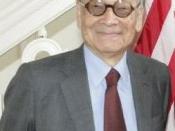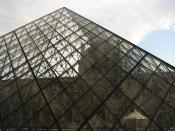The Chinese-American architect Ieoh Ming Pei (I.M) is known as one of the greatest architects of the Twentieth Century. His long, brilliant career was highlighted by several internationally famous structures. While many of Pei?s buildings were generally accepted by the public, some of them precipitated fair amounts of controversy. The most notable of these controversial structures is his Glass Pyramid at the entrance of the Louvre in Paris. For these reasons, I.M. Pei seems to be an architect who exhibits interest in the avant-garde through both the creative design and aestheticism of his architecture.
Pei was born in China in 1917 and immigrated to the United States in 1935. He originally attended the University of Pennsylvania but grew unconfident in his drawing skills so he dropped out and pursued engineering at MIT. After Pei decided to return to architecture, he earned degrees from both MIT and Harvard. In 1956, after he had taught at Harvard for three years, he established I.M.
Pei & Partners, an architectural firm that has been known as Pei Cobb Freed & Partners since 1989. This firm is famous for its successful and rational solutions to a variety of design problems. They are responsible for many of the largest pubic and private construction projects in the second half of this century. Some of these projects include the East Building of the National Gallery of Art in Washington D.C., the John F. Kennedy Memorial Library in Boston, and the Rock and Roll Hall of Fame in Cleveland.
When French President Francois Mitterand ?personally selected Mr. Pei in 1983 to design the Grand Louvre to give air, space, and light to one of the world?s most congested museums,? (Markham, 1989) there were many critics. The press ?lambasted the idea of shattering the harmony of the Louvre?s courtyard with...


